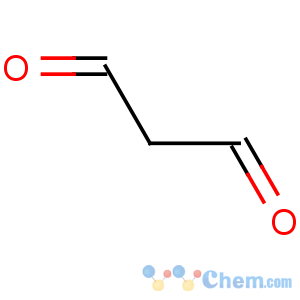Title: Malondialdehyde
CAS Registry Number: 542-78-9
CAS Name: Propanedial
Synonyms: malonaldehyde
Molecular Formula: C3H4O2
Molecular Weight: 72.06
Percent Composition: C 50.00%, H 5.60%, O 44.41%
Literature References: Endogenous product of lipid peroxidation and prostaglandin biosynthesis in mammals; also formed by oxidation of polyunsaturated fatty acids in foods. Reacts with functional groups of a variety of cellular compounds including DNA and amino acids, forming genotoxic adducts and crosslinks. Associated with detrimental protein modifications and decreased nutritional value in foods. Prepn: L. Claisen,
Ber. 36, 3664 (1903); R. Hüttel,
ibid. 74, 1825 (1941). Chemistry and reactions with amino acids: V. Nair
et al., J. Am. Chem. Soc. 103, 3030 (1981). NMR spectroscopy: S. H. Bertz, G. Dabbagh,
J. Org. Chem. 55, 5161 (1990). Determn methods using thiobarbituric acid: H. H. Draper
et al., Free Radical Biol. Med. 15, 353 (1993). HPLC determn in foods: P. Bergamo
et al., J. Agric. Food Chem. 46, 2171 (1998); in biological samples: R. Mateos
et al., J. Chromatogr. B 827, 76 (2005). Acute toxicity study: D. L. Crawford
et al., Toxicol. Appl. Pharmacol. 7, 826 (1965). Clinical use as biomarker in neurodegenerative disease: M. Dib
et al., J. Neurol. 249, 367 (2002); in coronary artery disease: H. H. Jung
et al., Am. J. Nephrol. 24, 537 (2004). Review of metabolism: H. H. Draper, M. Hadley,
Xenobiotica 20, 901-907 (1990); of biochemistry: H. Esterbauer
et al., Free Radical Biol. Med. 11, 81-128 (1991). Review of carcinogenic risk:
IARC Monographs 71, Part 3, 1037-1047 (1999); of toxicity of DNA adducts: L. J. Marnett,
IARC Sci. Publ. 150, 17-27 (1999); and pathological significance: D. Del Rio
et al., Nutr. Metab. Cardiovasc. Dis. 15, 316-328 (2005).
Properties: Needles, mp 72-74°. pKa (enolate) 4.46. Stable in neutral conditions but not in acidic. LD50 orally in rats: 632 mg/kg (Crawford).
Melting point: mp 72-74°
pKa: pKa (enolate) 4.46
Toxicity data: LD50 orally in rats: 632 mg/kg (Crawford)
Derivative Type: Sodium salt
CAS Registry Number: 24382-04-5
Molecular Formula: C3H4NaO2
Molecular Weight: 95.05
Percent Composition: C 37.91%, H 4.24%, Na 24.19%, O 33.67%
Properties: White needles from ethanol/ether, mp 246° (dec). uv max (0.01
M HCl): 245 nm (e 12800).
Melting point: mp 246° (dec)
Absorption maximum: uv max (0.01
M HCl): 245 nm (e 12800)
NOTE: Direct contact may cause irritation of eyes, skin and respiratory system; potential symptom of overexposure is CNS depression. Potential occupational carcinogen.
See NIOSH Pocket Guide to Chemical Hazards (2003-100121, 2003) p 190.
Use: Biomarker for oxidative stress. Index of oxidative rancidity in foods.

